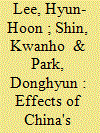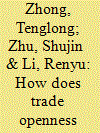| Srl | Item |
| 1 |
ID:
153056


|
|
|
|
|
| Summary/Abstract |
This paper examines the economic value of country image from the perspective of export prices through matching the CEPII export price data with the British Broadcasting Company country image data from 2006 to 2013. The estimation results show that positive country image has an “elevating” effect and negative country image has a “depressing” effect on export prices. The results also indicate that the lower the level of economic development of an export or import country, the stronger the export price effect of country image. As distances between export countries and trading partners increase, the elevating effect of positive country image on export prices becomes weaker. However, the depressing effect of negative country image does not become weaker over greater distances. We find that export prices are depressed by negative country image to a greater degree for China than for other countries. Therefore, it is necessary for China to prevent the occurrence of incidents detrimental to country image.
|
|
|
|
|
|
|
|
|
|
|
|
|
|
|
|
| 2 |
ID:
153053


|
|
|
|
|
| Summary/Abstract |
The Chinese economy is slowing down and is in the midst of a structural transformation from export-led and investment-led growth to domestic demand-led and consumption-led growth. While there are widespread concerns among China's trading partners about the effect of the slowdown in China's growth on their exports, China's structural changes are also likely to have a significant impact: for example, China will import fewer machines and more cosmetics. The central objective of the present paper is to empirically examine the effect of China's structural transformation on the exports of East Asian economies, which have close trade linkages with China. We find that economies that have failed to increase the share of consumption goods in their exports to China have suffered larger declines in their quantities of exports to China. In addition, economies that have suffered losses in their shares of China's parts and components imports have faced reductions in their shares in China's total imports.
|
|
|
|
|
|
|
|
|
|
|
|
|
|
|
|
| 3 |
ID:
153055


|
|
|
|
|
| Summary/Abstract |
The spatial distribution of population and economic activities has important impacts on both economic growth and the environment. This paper uses a slack-based measure to estimate the total factor environmental efficiency (TFEE) of 286 Chinese prefectural-and-above cities for the period 2002–2013. In particular, the relationship between city size and TFEE is investigated. The findings also show an inverted U-shaped relationship between TFEE and city size, which implies an optimal city size of 16.68 million residents in China. According to this estimate, most Chinese cities may be undersized due to the migration restrictions of the hukou registration system and, hence, suffer from great environmental efficiency losses. The estimated low average TFEE value of Chinese cities also suggests the large potential for efficiency improvement. Thus, government policies should focus on relaxing migration restrictions and encouraging the development of large cities.
|
|
|
|
|
|
|
|
|
|
|
|
|
|
|
|
| 4 |
ID:
153057


|
|
|
|
|
| Summary/Abstract |
This paper investigates the effect of trade openness and other variables on the demographic transition in China using the instrumental variables regression method based on provincial panel data for the period between 1981 and 2013. The results indicate that trade openness is one of the determinants of China's demographic transition and has two distinct effects: (i) an income effect that accelerated the demographic transition by increasing per capita income; and (ii) a human capital effect that suppressed the demographic transition by reducing human capital accumulation. The effects of trade on demographic transition vary across different regions. This study identifies the important determinants of demographic transition in China's regions, and has rich policy implications for demographic transition and the upgrading of trade structure.
|
|
|
|
|
|
|
|
|
|
|
|
|
|
|
|
| 5 |
ID:
153054


|
|
|
|
|
| Summary/Abstract |
Over the past three decades, we have seen a dramatic increase in the incidence of temporary trade barriers such as antidumping duties and countervailing duties. China has been at the receiving end of a large number of such measures. In this paper, we study how China's exports to its major trade partners have been affected when its major trade partners have used these measures either against China or against other countries. We find that Chinese exports to the country that imposed an antidumping duty decreased by approximately 35 percent. At the same time, an antidumping duty used by the importing country that was directed towards other countries but not against China led to an approximate 30-percent increase in China's exports to the policy-imposing country. These results remain robust across various specifications. Our findings have important policy implications. In particular, the magnitude of these effects highlights why it is important to curb the recent widespread use of these barriers.
|
|
|
|
|
|
|
|
|
|
|
|
|
|
|
|